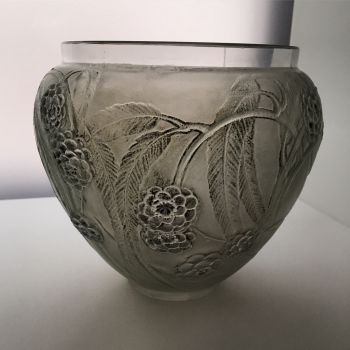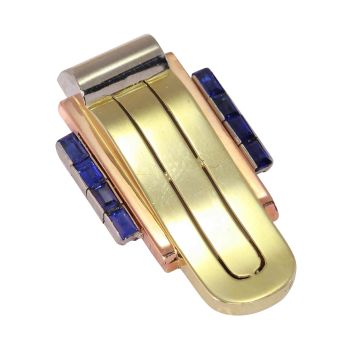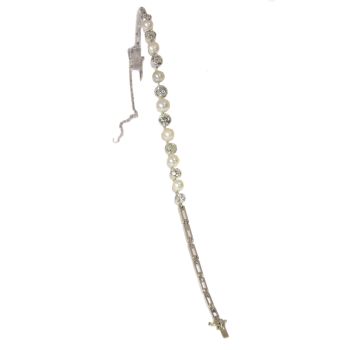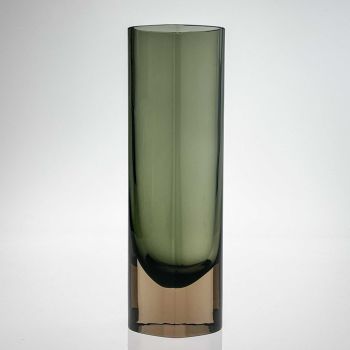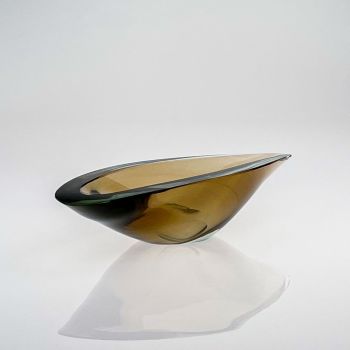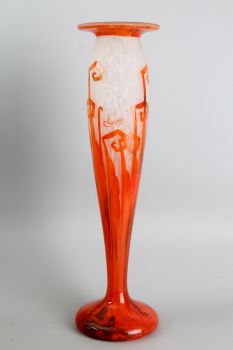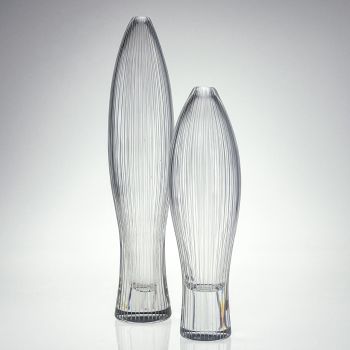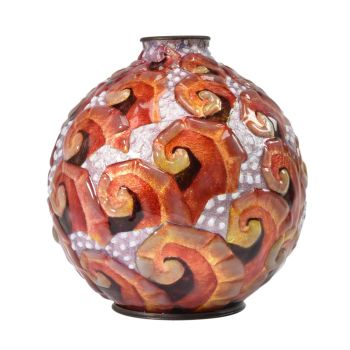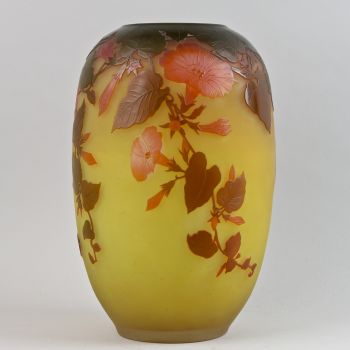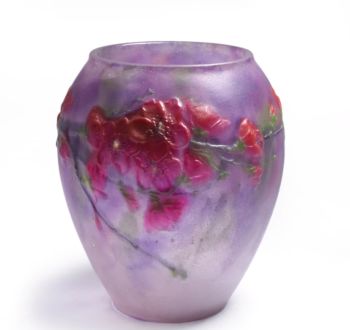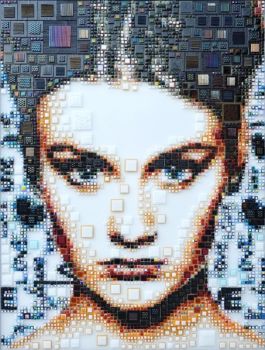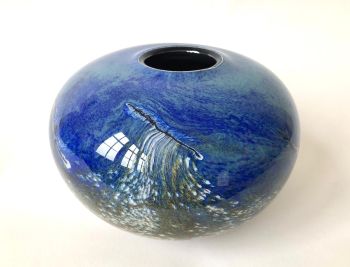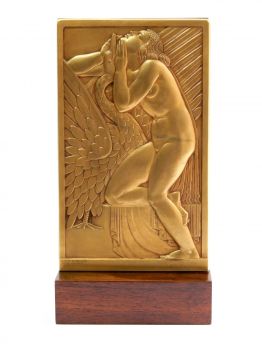Vase 'Gui' or Mistletoe 1920
René Lalique
Bicchiere
17 cm
ConditionNear mint
Prezzo su richiesta
Dille Art
- A proposito di opere d'arteThis vase with the refined decoration featuring mistletoe ('Gui' in French) is a beautiful design by René Lalique from 1920.
The exquisite way in which the mistletoe is intertwined with the vase is stunning. So elegant. This vase is made of opalescent glass, the berries and leaves are lightly polished for added accent.
The beauty of opalescent glass is that it takes on a milky blue-white colour when held up to light; when light is shone behind or through the vase, it takes on a golden yellow glow. René Lalique had a special recipe to achieve this effect optimally, using ingredients like arsenic and even real gold.
The vase is blown into the mould (soufflé moulé) and then carefully hand-finished. The vase bears model number 948, and the mould number is 1435.
This vase was produced relatively briefly because Lalique decided in the early 1930s to remove it, along with other vases, from the collection due to the depression. These vases were labour-intensive to make, still being blown into the mould rather than pressed, and finished by hand. The vase was only available from stock at that time. These vases are very popular among collectors today, partly because of their refined finish, but also because they are rarer due to the shorter production period.
The vase is signed 'R. Lalique' on the bottom.
Condition:
There is an enclosed black pinhead in the neck; it is visible but not tangible. Most likely happens with production of the vase. - A proposito di opere artistaRené Jules Lalique (6 aprile 1860, Ay, Marne - 1 maggio 1945, Parigi) è nato il 6 aprile 1860 ad Ay, Marne. Era un designer di vetro francese noto per le sue creazioni di arte del vetro, bottiglie di profumo, vasi, gioielli, lampadari, orologi e ornamenti per cofani di automobili. Nel 1872, all'età di dodici anni, entrò al Collège Turgot dove iniziò a disegnare e disegnare. Ha frequentato corsi serali presso l'Ecole des arts décoratifs. Lavorò lì dal 1874 al 1876 e successivamente trascorse due anni alla Crystal Palace School of Art di Sydenham, a Londra. Al Sydenham Art College, le sue capacità di progettazione grafica sono state migliorate e il suo approccio naturalistico all'arte è stato ulteriormente sviluppato. Quando tornò dall'Inghilterra, lavorò come artista freelance, disegnando gioielli per i gioiellieri francesi Cartier, Boucheron e altri. Nel 1885 aprì la propria attività e disegnò e realizzò i propri gioielli e altri pezzi di vetro. Nel 1890, Lalique è stato riconosciuto come uno dei più importanti designer di gioielli Art Nouveau in Francia; creando pezzi innovativi per il nuovo negozio parigino di Samuel Bing, Maison de l'Art Nouveau. È diventato uno dei più famosi nel suo campo, il suo nome è sinonimo di creatività, bellezza e qualità. Lalique era meglio conosciuto per le sue creazioni nell'arte del vetro. Negli anni '20, divenne famoso per il suo lavoro in stile Art Déco. A lui si devono le pareti di vetro illuminato e le eleganti colonne di vetro colorato che riempivano la sala da pranzo e il "grand salon" della SS Normandie e gli arredi interni, croce, paraventi, pala d'altare e fonte battesimale della chiesa di St. Matthew a Millbrook nel Jersey ( La "Glass Church" di Lalique. Le sue prime esperienze ad Ay furono la sua influenza determinante nel suo lavoro successivo. Di conseguenza, molti dei suoi gioielli e vasi mostrano piante, fiori e linee fluide. Opere uniche e commerciali di René Lalique sono nelle collezioni di un gran numero di musei pubblici in tutto il mondo, tra cui il Museu Calouste Gulbenkian a Lisbona, il Musée Lalique e il Musée des Arts Décoratifs in Francia, lo Schmuckmuseum Pforzheim in Germania, il Victoria e l'Albert Museum di Londra, il Metropolitan Museum e il Corning Museum nello Stato di New York e il Rijksmuseum di Amsterdam. René Lalique muore il primo maggio 1945 a Parigi.
Sei interessato ad acquistare questa opera d'arte?
Artwork details
Categoria
Soggetto
Stile
Materiale e Tecnica
Colore
Related artworks
- 1 - 4 / 12
- 1 - 4 / 24
Johann Loetz (Lötz) Witwe Klostermühle
Johann Loetz Witwe – Ausfuehrung 146 Titania vase – 19121910 - 1919
Preis auf AnfrageAntiques Emporium
Johann Loetz (Lötz) Witwe Klostermühle
Johann Loetz Witwe - Phänomen Genre 7773 – Orange1900 - 1910
Preis auf AnfrageAntiques Emporium
Demetre Chiparus
Demetre H. Chiparus – Bronze Art Deco statue “Rapture” – Édition Etling, Paris1920 - 1929
Preis auf AnfrageAntiques Emporium
1 - 4 / 24Herman Bogman jr.
Flower still life of a nasturtium in a blue vase1950 - 1965
Preis auf AnfrageAdelwein Kunst
René Lalique
Eine sehr seltene tiefgrüne Fougeres-Vase, entworfen von R. Lalique1912
€ 8.950Lennart Booij Fine Art and Rare Items
 Kuratiert von
Kuratiert vonSilla Scheepens
Paulus Franciscus Kromjong
Blumen vor Arearea Aka (Freude) von Gauguin '20th century
Preis auf AnfrageZebregs & Röell - Fine Art - Antiques
1 - 4 / 24Unbekannter Künstler
Ein seltenes Filigrana, ein Retortoli-Becher1550 - 1600
Preis auf AnfragePeter Korf de Gidts - Antiquairs
1 - 4 / 24- 1 - 4 / 12


















